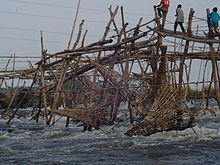Fish trap

A fish trap is a trap used for fishing. Fish traps may have the form of a fishing weir or a lobster trap. A typical trap might consist of a frame of thick steel wire in the shape of a heart, with chicken wire stretched around it. The mesh wraps around the frame and then tapers into the inside of the trap. When a fish swims inside through this opening, it cannot get out, as the chicken wire opening bends back into its original narrowness. In earlier times, traps were constructed of wood and fibre.
History

Traps are culturally almost universal and seem to have been independently invented many times. There are essentially two types of trap, a permanent or semi-permanent structure placed in a river or tidal area and pot-traps that are baited to attract prey and periodically lifted.
The prehistoric Yaghan people who inhabited the Tierra Del Fuego area constructed stonework in shallow inlets that would effectively confine fish at low tide levels. Some of this extant stonework survives at Bahia Wulaia at the Bahia Wulaia Dome Middens archaeological site.[1]
In southern Italy, during the 17th century, a new fishing technique began to be used. The trabucco is an old fishing machine typical of the coast of Gargano protected as historical monuments by the homonym National Park. This giant trap, built in structural wood, is spread along the coast of southern Adriatic especially in the province of Foggia and also in some parts of the coast of southern Tyrrhenian Sea.
Indigenous Australians were, prior to European colonisation, most populous in Australia's better-watered areas such as the Murray-Darling river system of the south-east. Here, where water levels fluctuate seasonally, indigenous people constructed ingenious stone fish traps.[2] Most have been completely or partially destroyed. The largest and best-known are those on the Barwon River at Brewarrina, New South Wales, which are at least partly preserved.[3] The Brewarrina fish traps caught huge numbers of migratory native fish as the Barwon River rose in flood and then fell. In southern Victoria, indigenous people created an elaborate system of canals, some more than 2 km long. The purpose of these canals was to attract and catch eels, a fish of short coastal rivers (as opposed to rivers of the Murray-Darling system). The eels were caught by a variety of traps including stone walls constructed across canals with a net placed across an opening in the wall. Traps at different levels in the marsh came into operation as the water level rose and fell. Somewhat similar stone-wall traps were constructed by native American Pit River people in north-eastern California.[4]
A technique called dam fishing is used by the Baka pygmies. This involves the construction of a temporary dam resulting in a drop in the water levels downstream— allowing fish to be easily collected.[5]
Use

The manner in which fish traps are used depends on local conditions and the behaviour of the local fish. For example, a fish trap might be placed in shallow water near rocks where pikes like to lie. If placed correctly, traps can be very effective. It is usually not necessary to check the trap daily, since the fish remain alive inside the trap, relatively unhurt. Because of this, the trap also allows for the release of undersized fish as per fishing regulations.
The Wagenya people, in the Democratic Republic of Congo, build a huge system of wooden tripods across the river. These tripods are anchored on the holes naturally carved in the rock by the water current. To these tripods are anchored large baskets, which are lowered in the rapids to "sieve" the waters for fish. The baskets are designed and sized to trap only large fish. The Wagenya lift the baskets twice daily to check for fish, which are retrieved by swimmers.
In the Great Lakes Region of the United States of America, fishermen submerse a long, visible mesh wall running perpendicular to the shoreline that guides fish (who instinctively swim towards deeper water when coming upon a large obstacle) into a maze that ends in a large mesh "pot", that can be raised up to the boat to haul the fish in. This method of fishing results in fish staying alive until the time they are hauled into the boat, as against being entangled and killed in a gill net. This method also allows for sportfish and other protected species to be released without harm.
In Finland, the portable fish trap called katiska is made from chicken wire. It is lightweight and enables easy portability of the traps. The trap can either be collapsible or rigid, and is easily placed at any depth, as it needs no anchoring.
-
Vietnamese traditional fish trap.
-
Fish traps at the Zuiderzee Museum, located in the Netherlands
-
Traditional trap in East Timor.
-
Trap used in Tamil Nadu.
-
Traditional tidal trap used in Kosi Bay, South Africa
Notes
| External image | |
|---|---|
- ^ C. Michael Hogan (2008) Bahia Wulaia Dome Middens, Megalithic Portal, ed. Andy Burnham
- ^ Jared Diamond: Guns, Germs, and Steel: The Fates of Human Societies. page 310. W.W. Norton & Company, March 1997. ISBN 0-393-03891-2.
- ^ Brewarrina Aboriginal Fish Traps.
- ^ Ajumawi Fish Traps.
- ^ Dam Fishing Fishing techniques of the Baka.
See also
External links






